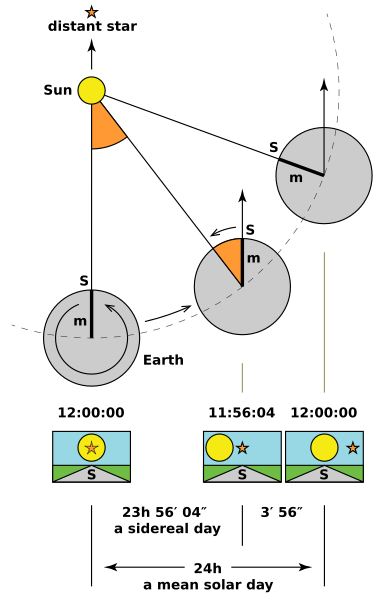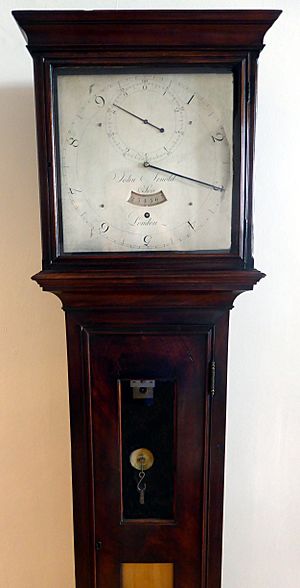Sidereal day facts for kids
Sidereal time is a special way to measure time. Astronomers, who study stars and planets, use it a lot. It helps them find objects in the night sky. Imagine you want to point a telescope at a specific star; sidereal time helps you know exactly where to look.
This time system is based on how fast Earth spins. But instead of looking at the Sun, it looks at very distant stars. Think of it as Earth's rotation measured against the "fixed" background of the stars.
Because Earth also moves around the Sun, a regular "solar day" (what we use every day) is a little longer than a sidereal day. A solar day is about 24 hours. A sidereal day is about 23 hours, 56 minutes, and 4 seconds. This means a star will appear to rise about four minutes earlier each night compared to our clocks. This is why different stars are visible at different times of the year!
Contents
What is Sidereal Time?
Sidereal time helps astronomers track the exact position of stars and other space objects. It's like a special clock that keeps time based on how Earth spins compared to distant stars.
Why is it different from solar time?
Our everyday time, called solar time, is based on the Sun. It measures how long it takes for the Sun to appear in the same spot in the sky again. This is about 24 hours.
A sidereal day is shorter than a solar day. It measures how long it takes for a distant star to appear in the same spot again. This difference happens because Earth is always moving in its orbit around the Sun.
Sidereal Day vs. Solar Day

Earth spins around its axis once in a sidereal day. But during that spin, it also moves a small distance along its path around the Sun. So, after one sidereal day, Earth needs to spin just a little bit more for the Sun to be in the same spot again. This extra spin makes a solar day almost 4 minutes longer than a sidereal day.
The stars are so incredibly far away that Earth's movement around the Sun doesn't really change where they appear in the sky. So, they return to their highest point in the sky in one sidereal day.
Think of it this way: In one year, Earth has about 365.24 solar days. But it has about 366.24 sidereal days! This extra day comes from Earth's journey around the Sun.
Sidereal Days on Other Planets
The difference between a sidereal day and a solar day changes for other planets.
How do other planets compare?
For planets farther from the Sun than Earth, like Mars or Jupiter, the difference between their sidereal and solar days is small. This is because they spin many times during one trip around the Sun.
But for planets closer to the Sun, like Mercury and Venus, it's very different!
- Mercury: Its sidereal day is about two-thirds of the time it takes to orbit the Sun. This means its solar day is much longer. One solar day on Mercury lasts for two trips around the Sun! That's three times longer than its sidereal day.
- Venus: Venus spins backward (retrograde). Its sidereal day is about 243 Earth days. This is even longer than its orbital period (the time it takes to go around the Sun), which is about 224.7 Earth days. Because of this, a solar day on Venus is about 116.8 Earth days long. Venus has almost two solar days for every trip it makes around the Sun.


